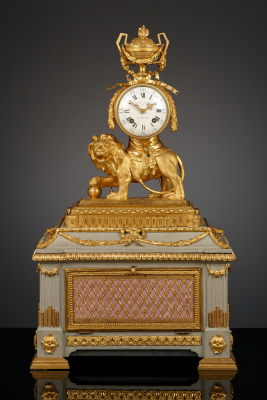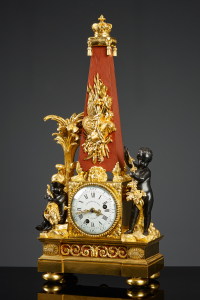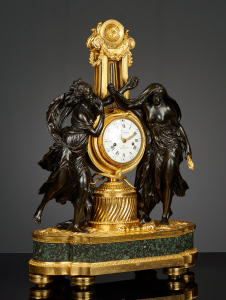French Louis XVI lion mantel clock with musical box
French Louis XVI lion mantel clock with musical box
The movement has an eight-day going train. The striking train with countwheel strikes the full hours on a large bell and the half hours on a small bell. The musical box with ten melodies plays a selected melody at every hour, using 21 hammers on 13 bells. Both the striking train and the musical train can be repeated on demand by way of a pull cord.
The enamelled dial indicates the hours using Roman numerals and the minutes using Arabic numerals, and is signed in red enamel in the centre: Dd Fc Dubois a Paris. The movement is signed on the back plate: ‘D.F.DB. David-Frédéric Dubois was accepted to the guild in 1780 and set up shop at Rue Saint-Honoré in 1781.’
Case
The dial is housed within a round, gilt case draped with a laurel festoon featuring an elegant bow and crowned with a festooned urn. The whole is borne on the back of a lion standing upon a gilt bronze base, with a ball under one of its front paws. The clock case stands upon a grey-lacquered box, elaborately decorated with gilt bronze, which houses the musical mechanism. The musical mechanism is accessible from both the front and the back by way of a hinged openwork grille with silk lining.
The composition of the gilt bronze lion clock was possibly based on a design by François Vion, but was executed by the Parisian bronzier Marie-Joseph Cottin, who was accepted to the bronziers’ guild in 1772.
François Vion (ca. 1737 - ca. 1790) was one of the most eminent bronziers of his time. Made maître in 1764, he specialised in clock cases, with many of his designs featuring animals. His clock cases are generally small in size, and stand out for the originality of their designs as well as their remarkably high-quality finish and level of detail. Many clocks by his hand found their way to royal palaces.
Literature:
Jean-Dominique Augarde, Les Ouvriers du Temps, fig. 268 p. 364
Pierre Kjellberg, La pendule Française, 1997, p. 279
- Provenance
- Pascal Izarn, Paris
Private collection, the Netherlands - Period
- ca. 1785
- Material
- gilt bronze, enamelled dial, lacquered wooden musical box
- Signature
- Dd. Fc. Dubois à Paris
- Dimensions
- 64 x 38 x 24 cm
Global shipping available









